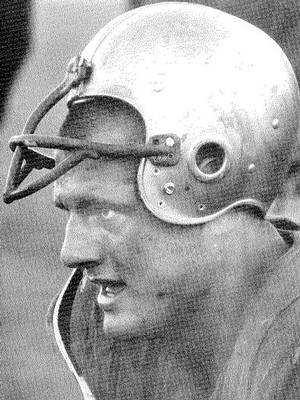

"More On Washington"
HELMET HUT NEWS/REFLECTIONS August 2009:
More On Washington
By Dr. Ken
The writing of the monthly HELMET NEWS/REFLECTIONS columns which appear on the HELMET HUT site need little or no prompting. Constantly and continuously, I have a focus upon football history, helmet construction, and health care matters related to the sport of football. That some of my thoughts appear in print is enjoyable for me as they serve as a point of emphasis to conversations or written exchanges I have had proximal to writing any specific column. Many of my professional colleagues and acquaintances view the series of columns as continuations of our conversations. Though much of the information from my era is now obscured by the passage of time and the growth of information which makes it irrelevant, there are those that can relate to the importance some of my choices for discussion had, when current.
Washington Head Football Coach Jim Owens, the subject of the July 2009
HELMET NEWS column was frequently credited with being the “man who saved West Coast football” as the ascension of his Huskies and the adoption of many of his coaching methods were copied in a manner similar to those of his mentor, Paul “Bear” Bryant. When Bryant returned to Alabama as head coach in 1958, he transformed a moribund program into one that was fighting for National Championships in but a few short seasons. Shug Jordan, head coach at rival Auburn noted that Bryant’s success forced every team in the Southeastern Conference to adopt what he called “a helmet busting, hell-for-leather” approach in order to keep up with Bryant’s Alabama program. Owens as noted in the Julycolumn, was the first to introduce what I termed “extreme conditioning methods” to West Coast football. This prompted one of the most highly regarded strength and conditioning coaches in the Cincinnati area to contact me for specific details. Owens truly did use extreme methods, and his “Death March” scrimmage has become part of Husky football folklore. Introducing the “Challenge Method” of determining starters was part of the quest for fitness and toughness, with any member of the team free to challenge one of his higher placed position mates for the right to keep that placement on the depth chart. Because Owens and his staff taught blocking and tackling techniques that utilized the forehead as the initial point of contact, he was the first to institute the use of neck exercises and what has come to be called “manual resistance” neck work to increase the strength and size of his players’ cervical spine musculature. With brush blocking and shoulder blocking techniques very much the standard for almost every other team on the coast, his purple-clad wild dogs were seen as dangerous and damaging. That Owens would actively participate and run punt coverage drills with his team during the week, added to the mystique of his early years.
As former Oakland Raiders star Ben Davidson stated, “I would say his (Owens) coaching style would not play these days. You couldn’t do that to people anymore…I always thought his strong point was his discipline.” Davidson noted that even summer camp with the demanding Vincent Lombardi was “no sweat” compared to what he had gone through at Washington. Just as Bryant had attracted criticism because of the volume and intensity of his conditioning program, so did Owens with many, especially in retrospect, expressing that he had “overdone it” with many of his physical demands. Still, as Davidson indicated, discipline and a true feeling of camaraderie carried those Husky teams, and this grew from the physical demands made upon the players. Unexpectedly, as the photo of a young University Of Washington two-way end named Ben Davidson indicates, the same level of discipline did not carry over into the equipment room.
 |
Ben Davidson at the University Of Washington
Close inspection of the early NOP style mask, originally designed to be attached with leather strapping but instead bolted onto Davidson’s helmet, clearly indicates that while the attachment points on each side may have been protected while gold paint was applied to the distinctive U W helmet, none was used to keep the new paint off of the center top part of the mask. Reminding the helmet aficionado of the painting done by equipment manager legend Roy “Friday” Macklem of the Detroit Lions [see HELMET HUT http://helmethut.com/Talkhelmet/TalkCollins.html ]
It was surprising that an exacting individual like Owens would allow what might be termed “less than exacting” paint repairs on his team’s helmets. Yet even into the mid-1960’s when the Huskies faced off against the powerful Rose Bowl squad of Illinois University led by Dick Butkus following the 1964 season, the paint runs on the masks remained clear for all to see.
|
|
Perhaps newly painted specifically for the Rose Bowl contest, fans might have hoped for uniform perfection yet the gold paint was included on all of the attachment points of the mask, as well as on the helmet shell.
If Huskies fans wonder if more modern helmet
painting and conditioning methods of the early
1970’s obviated the ongoing problem, a glance at All
American quarterback Sonny Sixkiller’s helmet and
mask is a convincing form of proof that “this is
just the way they did it then.” Of course, as a
great fan of the University Of Washington teams of
Owens’ years, football uniforms, and specifically
helmets, I would note that the small differences or
irregularities often give great distinction to a
particular helmet or design. Thus, it is with
affection rather than any negativity that I bring
attention to the "excess of gold" in the
gold helmets of those great Huskies teams.
|
|